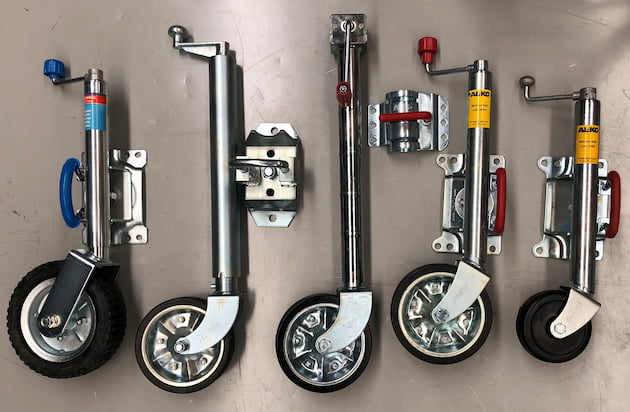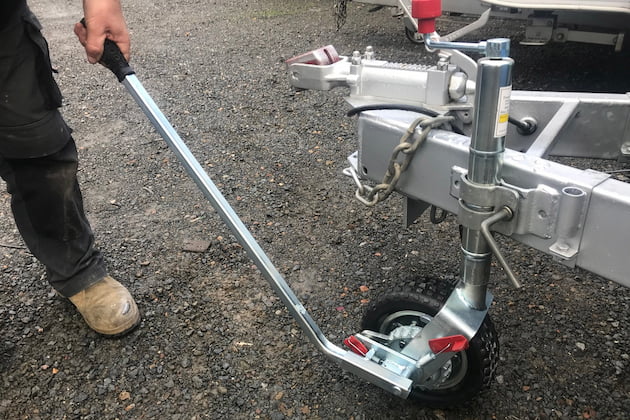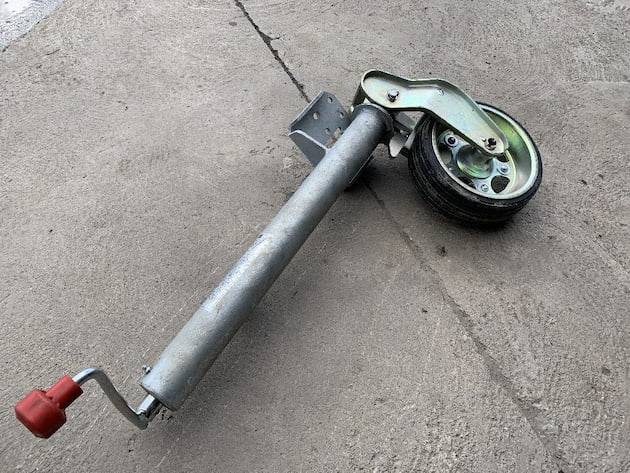The Complete Guide to Jockey Wheels
Jockey wheels are often overlooked trailer accessories. Their main purpose is to maneuver or ‘jockey’ a caravan or trailer to the towing vehicle when hitching or unhitching. They also serve to keep the caravan and trailer level when unhitched or parked and help to lower or lift trailers for easy loading and unloading.
Types of Jockey Wheels
There are several types of jockey wheels, and each will need to be compatible with the trailer or caravan in terms of loading capacity and overall lifting height. This allows for safe operation and simple maneuvering. Jockey wheels can be divided into standard, swivel bracket and ratchet types based on their designs, and in light, medium, and heavy-duty jockey wheels depending on the size and weight of the trailer they can handle.

Standard Jockey Wheels
A standard or fixed-clamp jockey wheel is welded or bolted onto the trailer drawbar. These are more common in smaller and older trailers and caravans. They provide little in the way of maneuvering but do have height adjustability. Often you’ll find standard wheels sitting on solid rubber wheels.
Swivel Bracket Jockey Wheels
These provide simple and quick operation. These too are fixed to the trailer but differ in one crucial way. An easy pull on the handle releases the locking pins and the jockey wheel swivels into position. Adjusting the height of the shaft is done with a top or side winding handle. Not only are swivel bracket types convenient, but move out of the way when not needed. Most sit on larger solid wheels, whereas heavy-duty jockey wheels in the swivel bracket variant offer higher loading capacities, and off-roading wheels can have more height adjustment in addition to two wheels for better articulation on looser surfaces.
Ratchet Jockey Wheels
Ratchet wheels are ideal for larger trailers and caravans that need to be moved in tight spots and up steep inclines. This allows you to move the vehicles without additional help. A long ratchet handle is slotted into the wheel and can be used to move trailers and caravans forward or backward. It also has a locking mechanism for added safety, a winding handle to adjust the height, and a high trailer nose weight making it adaptable to a range of differently sized vehicles. Most ratchet wheels sit on bigger solid rubber wheels, ensuring consistency across different surfaces.

Light, Medium, or Heavy-Duty? What’s Your Pick?
Light-duty options are suitable for single-axle unbraked trailers and smaller caravans weighing up to 750 kilos. They have shorter and thinner (usually 34mm) clamps and are good for maneuvering camping, motorbike, and smaller boat and dinghy trailers.
Medium-duty jockey wheels have 42 and 48mm clamps ideal for moving heavier single-axle and smaller dual-axle trailers weighing roughly 2 tons. These work well with flatbed trailers and horse floats.
Consider getting heavy-duty jockey wheels with a thicker and tougher 60 or 63-mm clamp when working with heavier twin-axle trailers weighing up to 3500 kilos. While smooth clamps work well in most applications, serrated clamps and shafts prevent the wheel from sliding in the clamp, so height is maintained even with the heaviest trailers. This is a good, but somewhat pricier option for commercial uses.
Tyre Sizes and Types
To make moving trailers and caravans easier across different terrain and surfaces and with less effort, tyre sizes, and materials will make a big difference. Wheels with 150mm diameter are seen in smaller light-duty variants. mid-sized wheels average 200mm and heavy-duty variants have 250mm wheels to carry more weight and make the task of moving heavier trailers and dual-axle caravans less of a burden. Generally, bigger overall diameters also mean wider tyres.

Tyres can also be pneumatic or solid rubber or nylon. The first type is air-filled and good when moving the trailer across sand and mud, but is prone to punctures. Solid rubber and nylon tyres work better on smooth surfaces like tarmac or concrete and tightly packed soils.
Closed and Open Heights
Closed height refers to the overall height of the unit from the top of the shaft to the bottom of the shaft, not including the wheel. This can be crucial in that it determines the clearance you have around the jockey wheel and trailer frame.
Open height is the overall height of the shaft from top to bottom (not including the wheel), when fully wound out and extending to the maximum height. For larger and heavier twin-axle trailers, a jockey wheel with a bigger open height makes hitching and unhitching easier, but the additional travel might not be necessary for single-axle caravans and trailers.
Final Word
Well-built and maintained jockey wheels should provide years of reliable use. However, issues with sliding or severely damaged shafts, damaged, cracked or punctured wheels, and faulty yokes that hinder pivoting are signs that you need a replacement. Also, consider replacing jockey wheels if the current one doesn’t meet your needs in terms of compatibility, loading capacity, heights, and the terrain on which you’ll usually be using the trailer or caravan. A properly-sized wheel able to support the weight of the trailer is also one that will be safer and easier to use.